Full Physiology Hemodynamic Data for the Entire Coronary Vasculature
With intuitive functionality, the CoroFlow‡ Cardiovascular System with the PressureWire™ X Guidewire provides full physiology data—enabling interventional cardiologists to assess both epicardial vessels and the microvasculature.1,2
CoroFlow‡ Software v3.7 Key Features
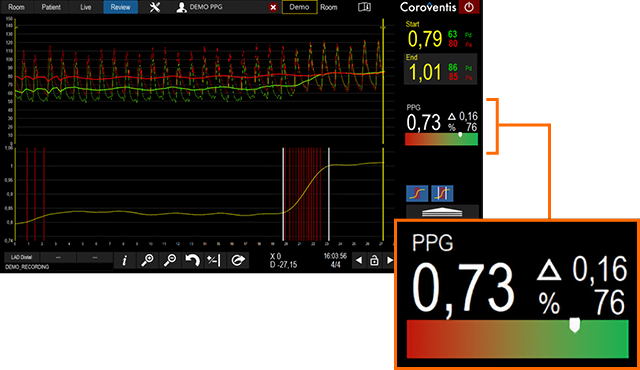
Full Physiology Insights Enhanced with PPG (Pullback Pressure Gradient)1
- CoroFlow‡ Software v3.7 offers a new clinical feature to measure PPG in FFR mode
- PPG is a novel epicardial index that quantifies focal and diffuse disease
- PPG assessment also displays
- ∆: Delta FFR between cursors
- %: Percentage of vessel FFR drop between cursors
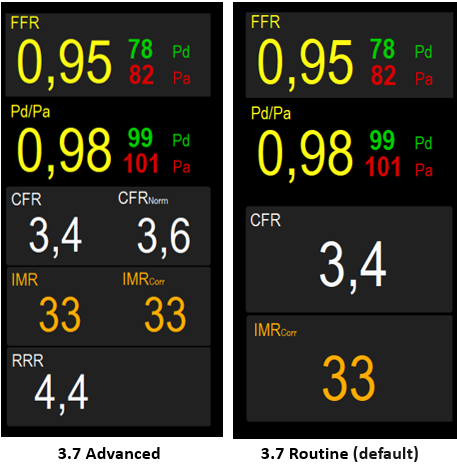
Tailored IMR/CFR Workflow Modes – Routine and Advanced1
- Routine mode simplifies screen and removes research indices
- Advanced mode same as previous version with research indices
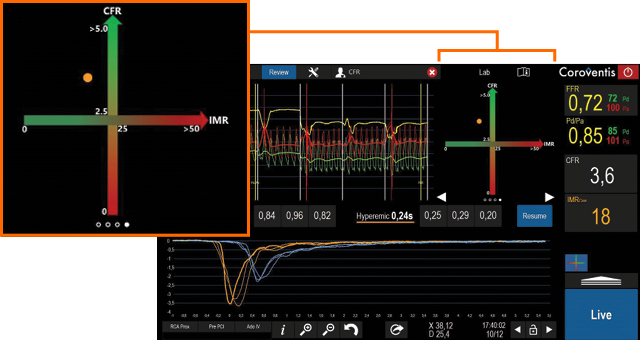
Visualize data interpretation with Full Physiology Result Matrix1
- Three selectable modes:
- CFR/IMR
- FFR/IMR
- FFR/CFR
- Physiology indices cut-offs:
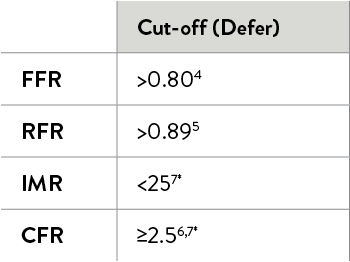
*IMR and CFR cutoffs in population of ischemia with no obstructive coronary artery disease (INOCA) patients, CorMicA trial.6
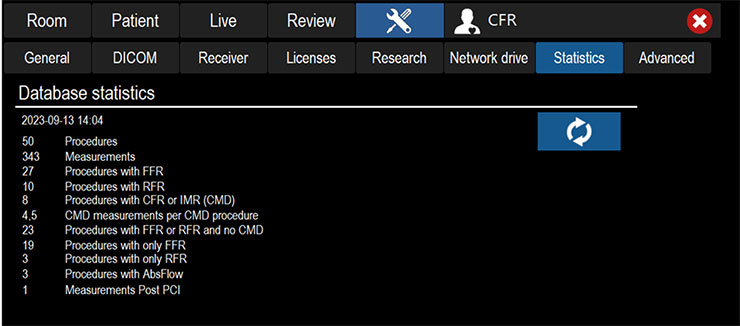
Statistic Tab for Full Physiology System Utilization1
- Detailed system use statistics
- Data copied to PC clipboard and saved in log file in system folder
Epicardial Assessment1
- FFR (Fractional Flow Reserve)
- RFR (Resting Full-cycle Ratio)—a non-hyperemic index that does not require adenosine infusion
- Pullback Pressure Gradient (PPG) via FFR pullback
- Pd/Pa
- RFR Pullback measurements
Microvascular Assessment1
- CFR (Coronary Flow Reserve)
- IMR (Index of Microcirculatory Resistance)
- Pullback CFR
- RRR (Resistance Reserve Ratio)
- Absolute flow/resistance
Ventricular Function1
- Contractility, dP/dt
- Diastolic function
- EDP (End Diastolic Pressure)
- Tau (Diastolic Relaxation Constant)
Utilization1
- Detailed system use statistics
- Data copied to PC clipboard and saved in log file in system folder
Other Features1
Wireless Communication
When used with the PressureWire™ X Guidewire and Wi-Box™, the CoroFlow‡ Cardiovascular System provides wireless communication, as well as simplified installation and use. The absence of cables means the absence of clutter in the workspace.
Digital Imaging and Communications in Medicine (DICOM†)
Workflow is simplified with the DICOM† Worklist. ICs can store both physiologic and angiographic data and images in one archive, e.g., picture archiving and communication system (PACS).
Cloud-Based Data Management
The system allows for secure remote data access—and multicenter study projects—by using cloud/network data storage.
Automated Study Data Management
Users can rely on greatly simplified study data management and database tools. To ensure data quality control and protection, the system provides built-in review and lock functions, as well as encrypted data storage/user access with Windows 10.
Multiple Export Options
Calculated measurement parameters and raw waveform data are exported easily into multiple formats and then to USB or cloud/network storage.
*As compared to all commercially available full physiology solutions outside of the U.S. as of Q2, 2025. Refer to IFUs for additional information. Full physiology refers to: Fractional Flow Reserve (FFR), Resting Full-cycle Ratio (RFR), Index of Microcirculatory Resistance (IMR), Coronary Flow Reserve (CFR) and Pullback Pressure Gradient (PPG). Data on file at Abbott.
References
- CoroFlow‡ Cardiovascular System Instructions for Use (IFU). Refer to IFU for additional information.
- PressureWire™ X Guidewire Instructions for Use (IFU). Refer to IFU for additional information.
- Data on file at Abbott.
- Tonino P, et al. Angiographic Versus Functional Severity of Coronary Artery Stenoses in the FAME Study. JACC. 2010;55:2816-2821.
- Svanerud J, et al. Validation of a novel non-hyperaemic index of coronary artery stenosis severity: the Resting Full-cycle Ratio (VALIDATE RFR) study. EuroIntervention. 2018;14:806-814.
- Ford TJ, et al., 1-year outcomes of angina management guided by invasive coronary function testing (CorMicA). J Am Coll Card Int. 2020;13:33-45.
- Kunadian C, et al. EAPCI Expert Consensus Document. EHJ. 2020:0,1-21.
MAT-2114953 v3.0
